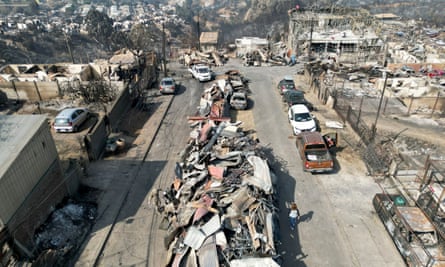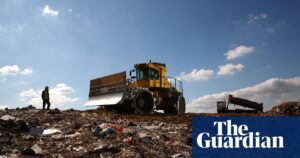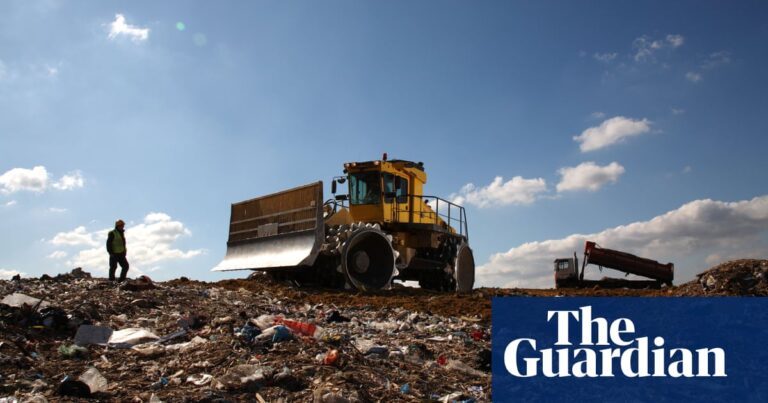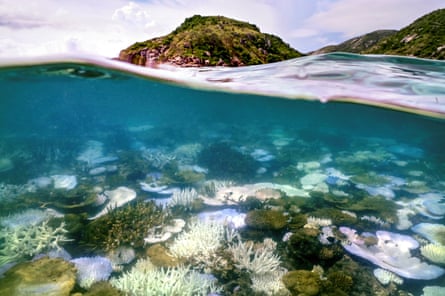Emergency crews in central Chile continued to discover bodies three days after wildfires began, as helicopters released large amounts of water onto the raging flames.
According to Marisol Prado, the director of Chile’s forensic medical service, the confirmed death toll of Chile’s most severe natural disaster in recent years has risen to 123 as of Monday. This number is expected to rise as efforts to remove debris continue by residents, firefighters, and military personnel.
On Friday, the intensity of forest fires increased and they reached residential neighborhoods in the coastal cities of Valparaíso and Viña Del Mar. The fires produced sparks and fireballs that quickly engulfed houses.
Jacqueline Atenas, 63, described the scene as reminiscent of a war zone or explosion. She was forced to evacuate her residence in Villa Independencia on Friday and returned on Monday to find everything destroyed except for a small pink backpack that she managed to salvage.
The houses were engulfed in flames, as if someone was pouring gasoline over them. I am confused about what caused this. The strong winds carried huge balls of fire through the air.
Luis Parra, who lives on the same street, shared that he and his family were able to narrowly escape their home with his wife and grandchildren. Unfortunately, the power had already gone out and they were unable to leave in their vehicle as the gate wouldn’t open.
Parra expressed disbelief at the tragic events that occurred when he and a friend were able to escape in a vehicle. Unfortunately, his sister and blind father did not survive the ordeal and their lifeless bodies were discovered just a block away from their residence.
Some people living in Villa Independencia, a low-income area in Viña del Mar, reported strong gusts of wind and a rapidly spreading fire.
59-year-old Ingrid Crespo reported that she initially spotted the fire in the distance on Friday and observed it spreading from one hill to another.
Crespo shared that the sparks were jumping and the wind was blowing fiercely, resembling a hurricane. When she noticed sparks coming into her roof, she attempted to douse them with water, but unfortunately, her home could not be saved.
She fled wearing sandals, with only the clothes on her back. Tragically, several of her neighbors perished and her beloved cat and dog also passed away in the fire.
Crespo shared, “When my son arrived on Sunday, he found multiple deceased individuals. The number of casualties is overwhelming.”
Chile began an official two-day mourning period on Monday. Hundreds of people are still missing and some 14,000 homes have been damaged, officials say.
Footage captured by a drone in the Viña del Mar region revealed entire neighborhoods ravaged by fire, with locals sifting through the remains of charred homes where corrugated metal roofs had caved in. Singed vehicles were also scattered along the streets.
Manuel Monsalve, the deputy interior minister, stated on Sunday evening that there are currently 165 ongoing fires, an increase from 154 on Saturday. In order to aid in containing the fires, a curfew has been enforced in the most heavily affected areas and the military has been deployed to assist the firefighters.
Monsalve mentioned that cooler temperatures and more cloud coverage may assist authorities in extinguishing the fires over the next few days.

In a press conference, Monsalve stated that we can expect consistently warm temperatures, but not dangerously high ones.
The PDI of Chile is conducting an investigation into potential cases of intentional fire starting within certain areas.
According to experts, Chile, Argentina, and other regions of South America’s southern cone are currently experiencing a harsh heat wave. This occurrence is expected to become more frequent during the summer months in the southern hemisphere due to the effects of climate change.
The El Niño weather phenomenon, which causes the Pacific Ocean to warm, has worsened the already extreme weather conditions in Chile.
Jesica Barrios, a resident of Viña del Mar whose home was destroyed, stated to Reuters that the fire suddenly appeared “in an instant”.
She explained that the flames had made their way to the botanical park and within 10 minutes, they were upon them. The air was filled with smoke and the once blue sky turned black, engulfing everything in darkness. The wind was so strong, it felt like a hurricane and the whole experience felt like being in hell.
Source: theguardian.com

















